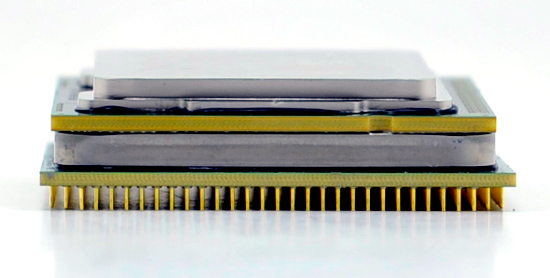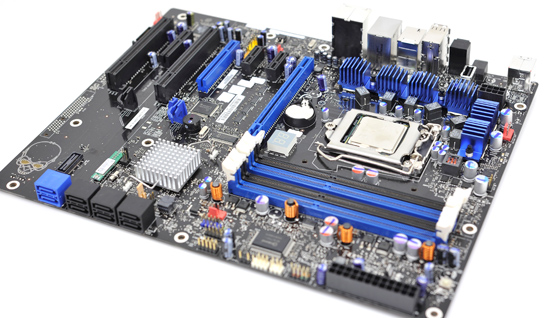Intel's Core i7 870 & i5 750, Lynnfield: Harder, Better, Faster Stronger
by Anand Lal Shimpi on September 8, 2009 12:00 AM EST- Posted in
- CPUs
Final Words
I'll start this conclusion with what AMD must do in response to Lynnfield. The Core i5 750 is a great processor at $196, in fact, it's the best quad-core CPU you can buy at that price today. In nearly every case it's faster than AMD's Phenom II X4 965 BE, despite the AMD processor costing almost another $50. Granted you can probably save some money on an integrated 785G motherboard, but if you're comparing ~$120 motherboards the AMD CPU is simply overpriced.

Lynnfield (top) vs. Phenom II (bottom)
Luckily, the solution isn't that difficult. AMD needs to lower prices. The problem is that AMD has too many products below $200 already. The Phenom II X3 and X4 series both exist below $200 and rumor has it that AMD is also going to introduce a quad-core Athlon II somewhere down there. Lynnfield's arrival causes a lot of price compression on AMD's side. The most AMD should sell the 965 BE for is $199, but if it is to remain competitive the chip needs to be priced much lower. That doesn't leave much room for other AMD CPUs. On the bright side, this could force AMD to simplify its product lines again (similar to what it has quietly been doing already).

The next thing that the Core i5 750 does is it finally ends the life of LGA-775. Just as was the case with AMD, the Core 2 Quad Q9650 is easily destroyed by the Core i5 750 and at a lower price. With significantly lower motherboard costs than the LGA-1366 chips, the Core i5 750 can actually compete in the high end LGA-775 space. It's only a matter of time before the sub-$200 LGA-775 parts are made obsolete as well.
Lynnfield power consumption is just excellent, these are the most power efficient quad-core CPUs we've ever tested. They use less power at idle than similarly clocked dual-core processors and under load they deliver better performance per watt than any of their closest competitors. Later this year we'll see 32nm dual-core Westmere start to ship for notebooks. I don't have performance data but I'd expect that early next year will be the perfect time to buy a new notebook.
Can you tell that I like the Core i5 750? Again, at $196 you can't find a better processor. Intel did its homework very well and managed to deliver something that kept AMD in check without completely upsetting the balancing of things. There's no technical reason that Intel couldn't have enabled Hyper Threading on the Core i5, it's purely a competitive move. A Core i5 750 with HT would not only defeat the purpose of most of the i7s, but it would also widen the performance gap with AMD. Intel doesn't need to maintain a huge performance advantage, just one that's good enough. While I'd love to have a 750 with HT, I'd still recommend one without it.
The Core i7 870 gets close enough to the Core i7 975 that I'm having a hard time justifying the LGA-1366 platform at all. As I see it, LGA-1366 has a few advantages:
1) High-end multi-GPU Performance
2) Stock Voltage Overclocking
3) Future support for 6-core Gulftown CPUs
If that list doesn't make you flinch, then Lynnfield is perfect. You'll save a bunch on a motherboard and the CPUs start at $196 instead of $284. We didn't have enough time with our Core i7 860 to include performance results here but my instincts tell me that at $284 that'll be the Lynnfield sweetspot. You get excellent turbo modes and Hyper Threading, without breaking $300.
Speaking of turbo, I'd say that Intel is definitely on to something here. The performance impact was small with Bloomfield, but turbo on Lynnfield is huge. My tests showed up to a 17% increase in performance depending on the workload, with most CPU-influenced scenarios seeing at least 9 or 10%. The turbo mode transitions happen fast enough to accelerate even simple actions like opening a new window. OS and application responsiveness is significantly improved as a result and it's something that you can actually feel when using a Lynnfield machine. It all works so seamlessly, you just always get the best performance you need. It's like Intel crammed the best single, dual and quad-core processors all into one package.
Perhaps that's what kept me from falling in love with Bloomfield right away. It was fast but in the same way that its predecessors were fast. If you didn't have a well threaded application, Bloomfield wasn't any better than a similarly clocked Penryn. Lynnfield's turbo modes change the game. Say goodbye to tradeoffs, the Core i5 and Core i7 are now fast regardless of thread count. It speed that is useful, it speed that you can feel, it's what truly makes Lynnfield the best desktop microprocessor of 2009. It's not just faster, it's smarter, it's better. It's why today's title borrows from Daft Punk and not Star Wars; it's not more of the same, it's something futuristic and new.
Lynnfield shows us the beginning of how all microprocessors are going to be made in the future. Even AMD is embracing turbo, we'll see it with Fusion in 2011. Extend turbo to its logical conclusion and you end up with something very exciting. Imagine a processor made up of many different cores, large and small, CPU and GPU. Each one turning on/off depending on the type of workload, and each running as fast as possible without dissipating more heat than your system can handle.
My only two complaints with Lynnfield are that the chips do require additional voltage (above stock) to overclock and of course the lack of Hyper Threading on the Core i5. It doesn't ruin the processor, but it gives us something to wish for.
Our work is never over.










343 Comments
View All Comments
moronsworld - Saturday, September 26, 2009 - link
To all you morons that don't understand economics. amd gone = intel monopoly = intel processors overpriced. Plain and simple. Take an economy class or 2, you morons. AMD is a good company, just that Intel's processors are better at the moment. God too many morons in this world that are allowed to vote. We live in a society ruled by morons.TA152H - Tuesday, September 8, 2009 - link
Actually, you don't really know what you're talking about.On-die memory controllers are nothing new. The Nexgen 586 had it in the mid-90s. Intel just knew when to add it, and when not to. That's why the Core 2 blows AMD processors away, while being significantly smaller.
AMD instruction schedulers were behind Intel's Pentium Pro from 1995 until the Phenom II came out. It still doesn't have full memory disambiguation like Intel introduced with the Core 2, but at least the memory scheduling is now on par with the Pentium Pro. I'm not sure that something they like brought up though.
64-bit processing is also old hat, and really was just an extension of the 386 protected mode anyway, with a lot of Microsoft input.
The K8 wasn't really much of an architecture, it was a K7 with a memory controller, and a couple of extra stages for better IPC, that most idiots thought was for higher clock speeds. It was a failure, and was what put AMD in the situation where they are now. It was, generally, better than the Netburst, but then, is that such a high bar to get over? The problem was, they actually believed it was a good processor until the Core 2 relieved them of that misapprehension. The reality is, Intel's mobile chips were always better than the K8, but the damn fools made us buy the Pentium 4 for the desktop. To AMD's credit, at least they never made anything horrible like that, but, really, their primary claim to fame was based more on the terrible Intel design than a great processor of their own, and the fact Intel wouldn't let us use the mobile chips for desktops.
JonnyDough - Tuesday, September 8, 2009 - link
Please work on your English before replying to me in the future. Thanks.Aenslead - Tuesday, September 8, 2009 - link
So you *must* have perfect english to reply in these forums?Gosh, never saw that in the Terms and Conditions agreement when I created my account. So that means that anybody (or a nobody, like you) have a say on what other races and people from other countries that don't speak English as their first language, that LIKE READING and giving their opinion in a FREE MOFO OPEN FORUM, must do to post here?
You and your kind are pathetic.
JonnyDough - Tuesday, September 8, 2009 - link
I didn't say anything about having perfect English. You sir, are a troll. I just wanted his reply to be coherent. This is the ENGLISH version of DailyTech, there are other language versions. His post didn't even make sense, and yours was just trolling.ginbong - Wednesday, September 9, 2009 - link
I understood what he said, maybe you need to sharpen up your analytical skills and stop being a dlckhead on this hardware analysis website.Better yet, how about taking the money you have saved for your next PC upgrade and enrolling into Grade 1 again.
dastruch - Tuesday, September 8, 2009 - link
and you don't get it too... patheticjigglywiggly - Tuesday, September 8, 2009 - link
This is a hot cpu, except I want 6 cores + HT. 32nm... quads ahh yeah. I still don't like the i5, because I don't want two sockets on one brand at the same time. It just limits options, I am only looking at i7/i9, because I bought this qx6700 in 2006 for 1000$. It was a good purchase, because q6600s were a while away and they were 500$. I got my qx6700 to 3.85ghz, now it's at 3.5ghz stable. Curse you electromigration! Also curse you economy! I don't have enough money for a 6core+6HT 1000$ cpu again.JonnyDough - Tuesday, September 8, 2009 - link
*Laughs at the moron...Go buy a Ferrari and then wreck it and sell it for parts. That's essentially a larger scale version of what you did.
Lifted - Tuesday, September 8, 2009 - link
Huh? Buying a $1000 CPU is like wrecking a Ferrari?"Laughs at the moron"